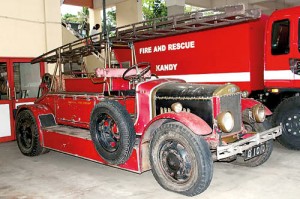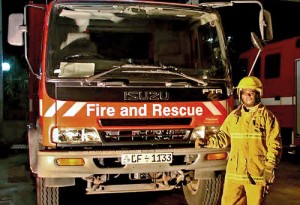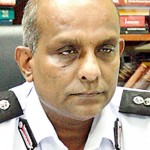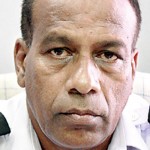Beacons flashing, sirens screaming, the firemen are on their way
The stillness of the wee morning hours is broken by the deep, piercing horn – two strong notes –of the rescue alarm. The watchers jump from their games of carrom and quiet conversation, running towards the sliding pole and the staircase, stuffing arms and legs through massive yellow jackets, pulling on gloves and rubber boots, grabbing helmets. Within seconds they are assembled downstairs, the rumble and roar of engines filling their ears as they haul themselves into the massive red and white trucks.

The oldest fire engine in the country (above). Pix by Ashwin Dominique Jayalath
In under a minute, 20 strong men are being spun away on ten wheels, each as tall as three-and-a-half feet, contained within a mass of shiny red metal, with some of the most potent hand-held equipment in use, beacons flashing, sirens screaming, to the site of a fire.
A historical record of the Fire Brigade or services in Sri Lanka, is not formally maintained, says Acting Divisional Fire Officer of the CMC service, R. G. Wijesuriya. Firefighting was formalized in Sri Lanka, in 1892, with water and sand buckets and watch towers being the main tools for detection and control of fires. With the popularization of horse-drawn carts, containers became bigger, and transport faster, tube-well pumps and horse-drawn water tanks of up to 200L capacity becoming a staple by the early 1900s.
Probably the oldest engine in the island, a turbine fire engine built April 15, 1921, in Guildford, England at Dennis Bros. Ltd., was in service here until the late 1980s or early 1990s. Unlike the newer models, this engine had no holding capacity of its own, but needed to be fed from external water sources. It served last at a car race on the Kandy Lake Round, and now sits, rather dusty and forlorn, but still sturdy, at the premises of the Kandy MC Fire Services Division on William Gopallawa Mawatha, a reminder to present fire fighters of the glory their vocation once commanded, and still commands, all over the globe.

Ready to go: Firefighter W.A. P.S. Wanasinghe in full gear at the Kandy Fire Services Division
The Fire Brigade was brought under the command of the Air Force following the Central Bank bombing of January 1996. Firefighters sought legal action against this move, and in October 1998 the Supreme Court ruled that fire services be brought under provincial government. The need for strengthening emergency-response teams was vividly demonstrated in the wake of the tsunami, and a scheme for developing the fire and rescue services of Sri Lanka was brought into place with international support. Their current focus is the establishment of fire and rescue services island-wide, through the existing provincial government system.
One major challenge the fire and rescue services face as a national institution is the fact that they are a decentralized system. The efficiency of the fire and rescue teams and their ability to respond to fire calls outside their designated precincts is therefore dependent

Chief Fire Officer P.N. R. Fernando
upon the responsiveness of their respective authorities. The Colombo Municipal Council Fire Services Division is the only municipal fire division in the country authorized to respond to fire calls outside its precinct. All others must seek prior approval. In a field of work where every additional second has the power to determine the success of an operation, half an hour’s delay getting through red tape can end up costing lives and irreparable damage to property.
Currently 18 Fire Service divisions function under local governments, with professionally trained firefighters, well equipped fire-trucks and ambulances. A number of smaller fire stations operate through the services of non-professionals who have basic fire and emergency training to deal with small contingencies. Nevertheless, sophisticated firefighting equipment, such as fire engines, cannot be handled without professional training, says Wijesuriya, who has been in the field for the last 35 years. The system is currently badly understaffed, but 130 trainees will soon join the current 200-plus professional force working across the island.
Sri Lanka’s only fire and rescue training programme, based at the Wellawatte Fire and Rescue Training Academy (FRTA), spans a year, preparing professional firefighters for highly specialized activities. A professionally trained firefighter has the knowledge and skills necessary to handle domestic fires, fires in air and water craft, refinery fires, road accidents as well as providing first-aid and dealing with hazardous materials (HAZMAT).
On the way to a site, sitting in the small room behind the Motorman driving the Fire Engine, the Officer in Charge of the crew briefs the others. Based on prior knowledge of the site and surroundings, a basic plan is laid out, but the strategy than conquers the elements is one that evolves taking the structural, chemical and climatic changes into consideration. It’s not all just standing in front of the flames and spraying water.
“Firefighting is based on science,” explains Wijesuriya, “firefighters need to understand the chemical and physical properties of fire and hazardous materials, they need to be able to analyse building structure, wind etc., and they need a thorough knowledge of human and animal biology to deal with casualties.” In addition to acquiring specialized knowledge in prevention, person and property protection and strategic

Acting Divisional Fire Officer R. G. Wijesuriya. Pix by Athula Devapriya
control of structural fires, professional firefighters are trained in hospitals to administer IV, vaccinations and oxygen and perform other basic emergency medical treatments. Unfortunately, the public do not recognize the knowledge and skill required of a professional fire fighter, Wijesuriya says, adding that “there have been many situations where fire-fighters are verbally and sometimes even physically abused, for being incompetent.”
One of the commonest complaints is that they arrive without sufficient water for dousing a fire. Some of the fire engines used by the CMC Fire Services Division have a holding capacity greater than 4000L. Water is pumped at a rate of upto 1500-2000L per minute, out of multiple hoses, resulting in the tanks being emptied sometimes in 30 seconds.
“It’s not unreasonable that people blame us for arriving ‘without enough water’,” Wijesuriya says. The fact of the matter is that these holding tanks are meant only to be an initial supply of water, which will be supplemented on reaching the site of the fire, by hydrants. But some of these hydrants, located at strategic points in the city, have been covered by building projects, and others are vandalised, making them useless, says Wijesuriya. The CMC Fire Services Division is currently working with the Water Board to unearth and restore these hydrants to working order, as well as build new ones. In the meantime, water bowsers with up to 8000L capacity follow fire engines to the reported location, to meet the water requirement in each situation.
Firefighters help put out fires, clear road accident sites and fallen trees, rescue trapped humans and animals, and respond as the situation requires, to most emergency calls. Fire engines and rescue vehicles contain scores of instruments including hydraulic cutters, pliers and separators with tool heads the size of basketballs, chainsaws and axes, bolt cutters and electric cutters for metal and concrete, ropes, harnesses, stretchers and beds, oxygen tanks, breathing apparatuses, cans and cans of foam, metres and metres of hosing, 1000Watt generator (“jenny”) powered flash lights, cones and traffic indicators, cannulas, saline and other basic items needed for minor surgery, and everything and anything that can come in handy in extreme situations. And every firefighter knows where each little item is.
Some of the bigger fire engines at the CMC Fire Services Division are too big to manoeuvre through the smaller streets of the city, and a large part of the firefighters’ strategy depends on protection and prevention, Chief Fire Officer at CMC Fire Services, P.N.R. Fernando says. Building structures which conform to fire-safety standards, safety equipment, evacuation plans and public awareness and training play a key role in this agenda.
Hence, in addition to emergency response activity, Fire Brigades also engage in training activity on request. After an initial meeting to assess the building, fire officials will engineer plans for alarm systems, evacuation routes and required equipment. Then they train small fire teams in handling equipment and leading evacuations as well as initial control of fire, through drills and demonstrations.
“Having volunteer fire teams on location is a great benefit to us,” says Wijesuriya. “The initial control of fire is very important, and there have been instances when we respond to a fire call to find that things are well under control by the time we get there.”
The pressing need, as Fernando sees it, is legislation on fire safety. “We can make recommendations, but the responsibility to implement is on other bodies.”
The Pettah has been identified as a high-risk area by CMC Fire Services. “Pettah is jam packed,” Fernando points out, “making it one of the areas most vulnerable to fire”. In a recent fire call in the area, he recalls that intervention was delayed by the difficulty officers had in locating the source of the fire. Lack of ventilation resulted in the surrounding area filling with smoke, causing visibility to be highly compromised.
Once the source is found, the structural composition of the area on fire, its surroundings, wind, ventilation, population density and many other factors are quickly grasped and used in strategizing the “attack”. Fighters are deployed with hosing and ropes, strategically positioned around the fire.
“There are four elements necessary for a fire to continue burning,” explains fire fighter Shanaka Weerasinghe from the Kandy MC Fire Services Division. The firefighters’ strategy takes the environment and surrounding into consideration and focuses on removing one or more of the elements: the reducing agent (fuel), heat, oxidizing agent (oxygen) and chemical reaction from this “tetrahedron”. Various scientific methods and techniques are utilized to best achieve the firefighters’ main objective: save lives, protect property – all this in the heat of fire, in the stress of buildings threatening to collapse, authorities balancing expenses and a public screaming for help.
May 4 was celebrated as International Firefighters Day around the globe, but Sri Lanka’s professional force remains unrecognized and un-applauded.


